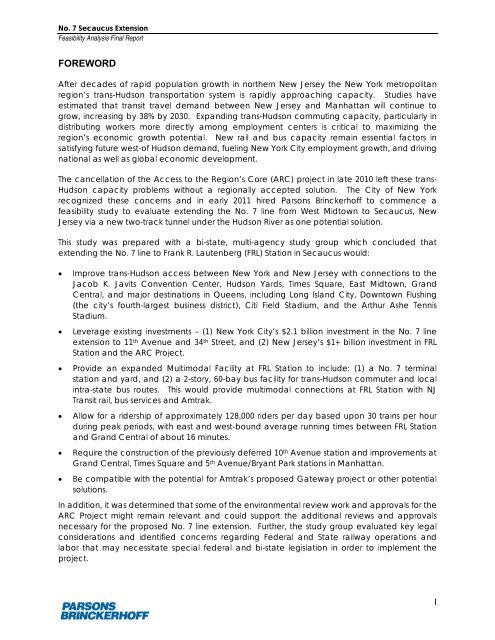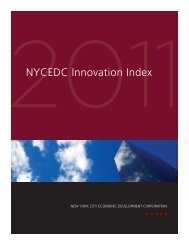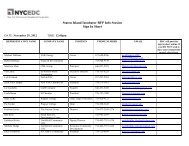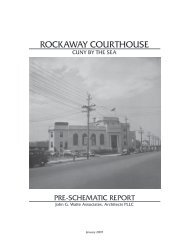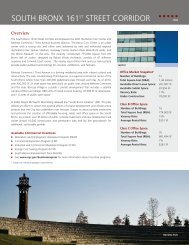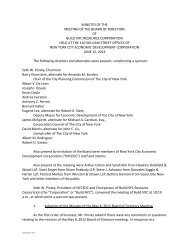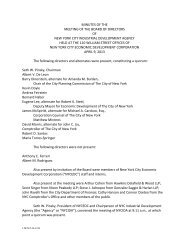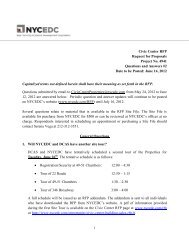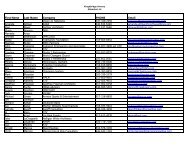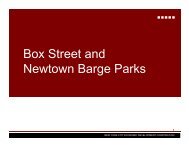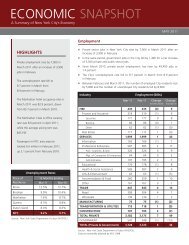No 7 Secaucus Extension Final Report - NYCEDC
No 7 Secaucus Extension Final Report - NYCEDC
No 7 Secaucus Extension Final Report - NYCEDC
You also want an ePaper? Increase the reach of your titles
YUMPU automatically turns print PDFs into web optimized ePapers that Google loves.
<strong>No</strong>. 7 <strong>Secaucus</strong> <strong>Extension</strong>Feasibility Analysis <strong>Final</strong> <strong>Report</strong>FOREWORDAfter decades of rapid population growth in northern New Jersey the New York metropolitanregion’s trans-Hudson transportation system is rapidly approaching capacity. Studies haveestimated that transit travel demand between New Jersey and Manhattan will continue togrow, increasing by 38% by 2030. Expanding trans-Hudson commuting capacity, particularly indistributing workers more directly among employment centers is critical to maximizing theregion’s economic growth potential. New rail and bus capacity remain essential factors insatisfying future west-of Hudson demand, fueling New York City employment growth, and drivingnational as well as global economic development.The cancellation of the Access to the Region’s Core (ARC) project in late 2010 left these trans-Hudson capacity problems without a regionally accepted solution. The City of New Yorkrecognized these concerns and in early 2011 hired Parsons Brinckerhoff to commence afeasibility study to evaluate extending the <strong>No</strong>. 7 line from West Midtown to <strong>Secaucus</strong>, NewJersey via a new two-track tunnel under the Hudson River as one potential solution.This study was prepared with a bi-state, multi-agency study group which concluded thatextending the <strong>No</strong>. 7 line to Frank R. Lautenberg (FRL) Station in <strong>Secaucus</strong> would:Improve trans-Hudson access between New York and New Jersey with connections to theJacob K. Javits Convention Center, Hudson Yards, Times Square, East Midtown, GrandCentral, and major destinations in Queens, including Long Island City, Downtown Flushing(the city’s fourth-largest business district), Citi Field Stadium, and the Arthur Ashe TennisStadium.Leverage existing investments – (1) New York City’s $2.1 billion investment in the <strong>No</strong>. 7 lineextension to 11 th Avenue and 34 th Street, and (2) New Jersey’s $1+ billion investment in FRLStation and the ARC Project.Provide an expanded Multimodal Facility at FRL Station to include: (1) a <strong>No</strong>. 7 terminalstation and yard, and (2) a 2-story, 60-bay bus facility for trans-Hudson commuter and localintra-state bus routes. This would provide multimodal connections at FRL Station with NJTransit rail, bus services and Amtrak.Allow for a ridership of approximately 128,000 riders per day based upon 30 trains per hourduring peak periods, with east and west-bound average running times between FRL Stationand Grand Central of about 16 minutes.Require the construction of the previously deferred 10 th Avenue station and improvements atGrand Central, Times Square and 5 th Avenue/Bryant Park stations in Manhattan.Be compatible with the potential for Amtrak’s proposed Gateway project or other potentialsolutions.In addition, it was determined that some of the environmental review work and approvals for theARC Project might remain relevant and could support the additional reviews and approvalsnecessary for the proposed <strong>No</strong>. 7 line extension. Further, the study group evaluated key legalconsiderations and identified concerns regarding Federal and State railway operations andlabor that may necessitate special federal and bi-state legislation in order to implement theproject.I


